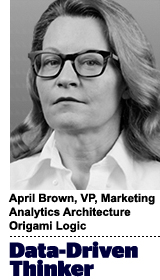
“Data-Driven Thinking” is written by members of the media community and contains fresh ideas on the digital revolution in media.
Today’s column is written by April Brown, vice president of marketing analytics architecture at Origami Logic.
Amid a nearly overpowering data deluge and its elusive utility, it is easy to forget the fundamental role of people with respect to this treasure trove – the people who are tasked with wrangling it, extracting insight from it and writing checks based on what it reveals.
Data represents significant power, but the best platforms in the world will fail when organizations don’t address how different people will interact with the data, and why.
Imagine a CPG company that plans a new initiative to be more data-driven, accountable and transparent with how it develops, deploys and manages its marketing. The company has many established brands and spends millions of media dollars each quarter with multiple agencies. It employs a marketing IT or data analytics team and market-mix modelers to create PowerPoint decks illustrating quarterly performance. The decks are consumed by leadership and may be seen by boots-on-the-ground marketers.
This data-driven initiative leads multiple stakeholders to interpret the data – where came from, its cleanliness, veracity and efficacy. Everyone has a point of view.
That’s no surprise, given the disparate roles at play in most hierarchical organizations. If you are an executive, your view is likely wide, generalized and focused primarily on spend and revenue, with a high-level overlay of marketing campaign performance, perhaps across brands and regions.
If you are a brand leader, you are focused almost exclusively on your brand, regardless of granularity. If you are responsible for a channel within a brand, you likely spend a lot of time very deep in a highly granular channel environment. If you are a programmatic trader, you probably focus on reach and bidding. And if you are a data scientist or marketing IT person, you are focused on accuracy, data hygiene and analysis.
Constructing a unified measurement strategy that addresses these disparate needs is incredibly laborious. If an organization gets to a point of pushing out a plan to all stakeholders, it often dies on the vine simply because it is not relevant to one or more stakeholders. In turn, these stakeholders go off and do their own thing, and before you know it, everyone is back on the crazy train. This usually takes about a year.
Yet there are several steps that can help put the power of data into the hands of each stakeholder, beginning with deciding which organizational goals should be measured for efficiency and effectiveness. Ask the intended consumers for their preferences on receiving this information and at what granularity.
Sketch out a matrix illustrating roles on one axis and efficiency and effectiveness on the other.
Determine the key KPIs that are directly related to organizational goals – keep it at a high level and S.M.A.R.T.
Construct views appropriate to the goals, stakeholders and granularity needed.
Get feedback – lots of feedback. Give everyone a voice. As quickly as practical discuss what insights can be gleaned from the data with all stakeholders, understanding how their unique views relate to the higher order of business objectives.
Even if companies don’t complete all of these steps perfectly, they will have included the people consuming the data in the decision-making process, ensuring their needs are met and their voices are heard while aligning with overall business objectives. In short, they will have given data’s power to the people.
Follow Origami Logic (@OrigamiLogic) and AdExchanger (@adexchanger) on Twitter.
This post was syndicated from Ad Exchanger.


More Stories
Meta’s Threads Begins Global Ad Rollout Within Its Feed
Adtech Firm Criteo Is Pitching Hundreds of Retailers on a New Video Ad
2degrees gets loud about NOtifications